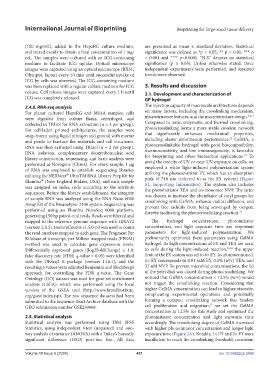Page 439 - IJB-10-5
P. 439
International Journal of Bioprinting Bioprinting for large-sized tissue delivery
(100 mg/mL), added to the HepaRG culture medium, are presented as mean ± standard deviation. Statistical
and mixed evenly to obtain a final concentration of 1 mg/ significance was defined as *p < 0.05, ** p < 0.01, *** p
mL. The samples were cultured with an ICG-containing < 0.001 and **** p<0.0001. “N.S.” denotes no statistical
medium to facilitate ICG uptake. Optical microscope significance (p ≥ 0.05). Unless otherwise stated, three
images were captured using an optical microscope (BX51; independent experiments were performed, and repeated
Olympus, Japan) every 10 min until successful uptake of trends were observed.
ICG by cells was observed. The ICG-containing medium
was then replaced with a regular culture medium for ICG 3. Results and discussion
release. Cell release images were captured every 1 h until 3.1. Development and characterization of
ICG was completely released. GP hydrogel
2.4.8. RNA-seq analysis The injection capacity of macroscale architectures depends
For planar cultured HepaRG and M14A samples, cells on many factors, including the crosslinking mechanism,
were digested from culture flasks, centrifuged, and microstructure features, and the macrostructure design. 20,21
collected in TRIzol for RNA extraction (n = 3 per group). Compared to ionic, enzymatic, and thermal crosslinking,
For cell-laden printed architectures, the samples were photocrosslinking forms a more stable covalent network
snap-frozen using liquid nitrogen and ground with mortar that significantly enhances mechanical properties,
22
and pestle to fracture the materials and cell structures. including elastic deformation performance. GelMA, a
RNA was then extracted using TRIzol (n = 2 per group). photocrosslinkable hydrogel with good biocompatibility,
RNA isolation, complementary deoxyribonucleic acid thermosensitivity, and low immunogenicity, is favorable
23
library construction, sequencing, and basic analysis were for bioprinting and other biomedical applications. To
performed at Novogene (China). For every sample, 1 µg avoid the toxicity of UV or near-UV exposure on cells, we
employed a white light-induced polymerization system
of RNA was employed to establish sequencing libraries utilizing the photosensitizer EY, which has an absorption
®
utilizing the NEBNext UltraTM RNA Library Prep Kit for peak of 510 nm (referred to as the EY system) (Figure
®
Illumina (New England Biolabs, USA), and each sample S1, Supporting Information). The system also includes
was assigned an index code according to the attribute the photoinitiator TEA and co-monomer NVP. The latter
sequences. Before the library establishment, the integrity was chosen to increase the abundance of vinyl groups for
of sample RNA was analyzed using the RNA Nano 6000 crosslinking with GelMA, enhance radical diffusion, and
Assay Kit of the Bioanalyzer 2100 system. Sequencing was prevent free radicals from being scavenged by oxygen,
performed using an Illumina NovaSeq 6000 platform, thereby facilitating the photocrosslinking reaction. 24
generating 150 bp paired-end reads. Reads were filtered and
mapped to the reference genome sequence with HISAT2 The hydrogel concentration, photoinitiator
(version 2.0.5). FeatureCounts v1.5.0-p3 was used to count concentration, and light exposure time are important
the read numbers mapped to each gene. The Fragment Per parameters for light-induced polymerization. We
Kilobase of transcript, per Million mapped reads (FPKM) preliminarily optimized these parameters using GelMA
method was used to calculate gene expression levels. hydrogel. As high concentrations of EY and TEA are toxic
Differentially expressed genes (|log2FoldChange| ≥ 1.0; to cells during the light-induced reaction, 25,26 the upper
false discovery rate [FDR] q-value < 0.05) were identified limit of the EY system was set to 4× EY. As aforementioned,
with the DESeq2 R package (version 1.16.1), and the 1× EY corresponds to 0.01 mM EY, 0.1% (w/v) TEA, and
resulting p values were adjusted Benjamini and Hochberg’s 37 nM NVP. To prevent microbial contaminations, the lid
approach for controlling the FDR q-value. The Gene of the petri dish was closed during photocrosslinking. We
Ontology (GO) dataset was used for gene set enrichment noticed that GelMA concentrations < 12.5% (w/v) would
analysis (GSEA), which was performed using the local not trigger the crosslinking reaction. Considering that
version of the GSEA tool (http://www.broadinstitute. higher GelMA concentration can lead to higher viscosity,
org/gsea/index.jsp). The raw sequence datasets had been complicating experimental operations and potentially
submitted to the Sequence Read Archive database with the forming a compact crosslinking network that hinders
27
GEO submission number GSE230068. cell proliferation and migration, we set the GelMA
concentration at 12.5% for this study and optimized the
2.5. Statistical analysis photoinitiator concentration and light exposure time
Statistical analysis was performed using IBM SPSS accordingly. The crosslinking degree of GelMA increased
Statistics, using independent t-test (unpaired) and one- with higher photoinitiator concentration and longer light
way analysis of variance (ANOVA) with a Tukey’s honestly exposure time (Figure 2A). Notably, 1× EY and 2× EY were
significant difference (HSD) post-hoc test. All data insufficient to reach the crosslinking threshold, consistent
Volume 10 Issue 5 (2024) 431 doi: 10.36922/ijb.3898

